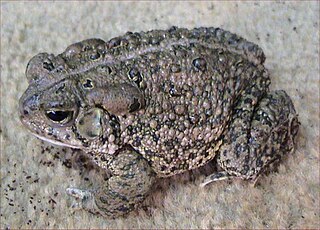
The cane toad, also known as the giant neotropical toad or marine toad, is a large, terrestrial true toad native to South and mainland Central America, but which has been introduced to various islands throughout Oceania and the Caribbean, as well as Northern Australia. It is a member of the genus Rhinella, which includes many true toad species found throughout Central and South America, but it was formerly assigned to the genus Bufo.

Bufo is a genus of true toads in the amphibian family Bufonidae. As traditionally defined, it was a wastebasket genus containing a large number of toads from much of the world but following taxonomic reviews most of these have been moved to other genera, leaving only seventeen extant species from Europe, northern Africa and Asia in this genus, including the well-known common toad. Some of the genera that contain species formerly placed in Bufo are Anaxyrus, Bufotes, Duttaphrynus, Epidalea and Rhinella.

The common toad, European toad, or in Anglophone parts of Europe, simply the toad, is a frog found throughout most of Europe, in the western part of North Asia, and in a small portion of Northwest Africa. It is one of a group of closely related animals that are descended from a common ancestral line of toads and which form a species complex. The toad is an inconspicuous animal as it usually lies hidden during the day. It becomes active at dusk and spends the night hunting for the invertebrates on which it feeds. It moves with a slow, ungainly walk or short jumps, and has greyish-brown skin covered with wart-like lumps.

Bufotenin is a tryptamine derivative, more specifically, a DMT analog, related to the neurotransmitter serotonin. It is an alkaloid found in some species of mushrooms, plants and toads, especially the skin.

Bufotoxins are a family of toxic steroid lactones or substituted tryptamines of which some are toxic. They occur in the parotoid glands, skin, and poison of many toads and other amphibians, and in some plants and mushrooms. The exact composition varies greatly with the specific source of the toxin. It can contain 5-MeO-DMT, bufagins, bufalin, bufotalin, bufotenin, bufothionine, dehydrobufotenine, epinephrine, norepinephrine, and serotonin. Some authors have also used the term bufotoxin to describe the conjugate of a bufagin with suberylarginine.

Bufotalin is a cardiotoxic bufanolide steroid, cardiac glycoside analogue, secreted by a number of toad species. Bufotalin can be extracted from the skin parotoid glands of several types of toad.
The guaracha is a genre of music that originated in Cuba, of rapid tempo and comic or picaresque lyrics. The word has been used in this sense at least since the late 18th and early 19th century. Guarachas were played and sung in musical theatres and in working-class dance salons. They became an integral part of bufo comic theatre in the mid-19th century. During the later 19th and the early 20th century the guaracha was a favourite musical form in the brothels of Havana. The guaracha survives today in the repertoires of some trova musicians, conjuntos and Cuban-style big bands.

The Colorado River toad, also known as the Sonoran Desert toad, is a toad species found in northwestern Mexico and the southwestern United States. It is well known for its ability to exude toxins from glands within its skin that have psychoactive properties.

The European green toad is a species of true toad found in steppes, mountainous areas, semi-deserts, urban areas and other habitats in mainland Europe, ranging from far eastern France and Denmark to the Balkans, Western Russia and the Caucasus. As historically defined, the species ranged east through the Middle East and Central Asia to western China, Mongolia and northwestern India, and south through Italy and the Mediterranean islands to North Africa.

The American toad is a common species of toad found throughout Canada and the eastern United States. It is divided into three subspecies: the eastern American toad, the dwarf American toad and the rare Hudson Bay toad. Recent taxonomic treatments place this species in the genus Anaxyrus instead of Bufo.

Woodhouse's toad is a medium-sized true toad native to the United States and Mexico. There are three recognized subspecies. A. woodhousii tends to hybridize with Anaxyrus americanus where their ranges overlap.

The Asiatic toad or Chusan Island toad is a species of toad endemic to East Asia. The species was previously classified as Bufo bufo gargarizans, a subspecies of the common toad.
The toad mouse is a species of rodent in the family Muridae. It is found in Burundi, Democratic Republic of the Congo, Rwanda, and Uganda. Its natural habitats are subtropical or tropical moist montane forests and arable land.

Marinobufagenin (marinobufagin) is a cardiotonic bufadienolide steroid. It can be found in the plasma and urine of human subjects with myocardial infarction, kidney failure, and heart failure. It is also secreted by the toad Bufo rubescens and other related species such as Bufo marinus. It is a vasoconstrictor with effects similar to digitalis.

Bufotenidine, also known as 5-hydroxy-N,N,N-trimethyltryptammonium (5-HTQ), is a toxin related to bufotenin, serotonin, and other tryptamines which is found in the venom of a variety of toads. It acts as a selective 5-HT3 receptor agonist, and has been used in scientific research to study the function of the 5-HT3 receptor, though this use has been limited by the fact that, as a quaternary amine, it is unable to readily cross the blood-brain-barrier.
Morimopsini is a tribe of longhorn beetles of the subfamily Lamiinae. It was described by Lacordaire in 1869.
Apomempsis densepunctata is a species of beetle in the family Cerambycidae. It was described by Stephan von Breuning in 1939. It is known from Gabon and the Democratic Republic of the Congo.












